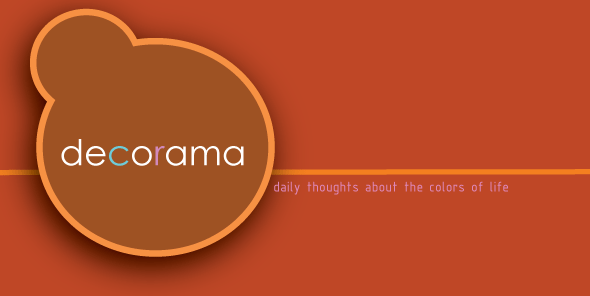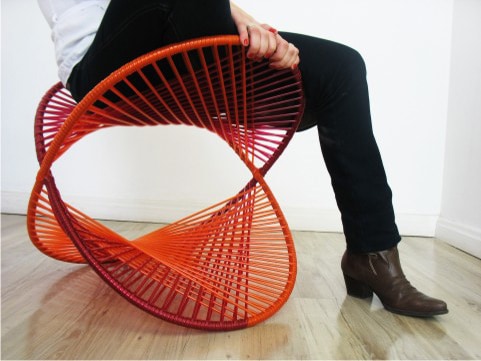What is this?
Color-changing dyes and additives have been offered in paper, plastic and textiles for some time, but this product takes the idea into a new area: glass tiles. Offered in a range of colors and sensitivities, the tiles change color based on ambient temperature, body temperature or water temperature – whatever they’re touching.
The textured glass surface layer protects and highlights the color-change film on the tile. The base color of the tile can match almost any color, and the temperature change point can be fit to the user’s environment and requirements. The dynamic color change begins at the selected activation temperature and shimmers through three phases, one with each 6 – 10° rise in temperature. Once the temperature peak is passed, the base color returns and remains the same until the temperature drops.
The tiles come in six standard lines; each is a different glass texture, and each offers the changing display in different color moods and ranges, all matched by complementary decos and liners. In bath/shower rooms and other areas, the tiles could form beautiful water temperature safety gauges or be a visual room temperature marker. But this technology has also been used in art pieces that transform with temperature changes: In one, a cityscape changes from a day to a night scene, complete with lights. The tiles can be used on floors, walls and counters — and, because they use glass that is 20 – 80% recycled, they’re a green product.
Vendor Interview
In a few sentences, what is it that is unique about this item for product developers?
This glass product is unique due to its ability to change color and or image through any kind of change in temperature. Examples are human touch, a change in ambient temperature, warm/cold water; anywhere a heat or cold source is present. In addition, it can be designed in any size/thickness of glass, color/colors, and multiple activation temperatures. The base color can also be color matched to virtually any color imaginable.
What are the primary disadvantages of the existing technologies that this is an alternative for?
They don’t do anything! Our state of the art products breathes life into stagnant environments, while most all glass, art, and building materials just sit there. Introducing Moving Color technology, either by itself or blending with other materials, achieves aesthetics like nothing else in the world.
What industries is this item typically used in?
Currently our Temperature Sensitive Glass is used in Architectural Design ranging from small glass tiles to large architectural pieces. All of our glass is rated for floors, walls, and counters. We are also a “Green Product” and use 20 – 80% recycled glass.
Examples of products currently or formerly on the market that make use of this:
Last year we had the opportunity to work with Disney. Together we created unique glass tiles that are installed in the Mickey Mouse Penthouse at the Disneyland Hotel. When Disney’s guests take a shower, the warm water hits the glass, causing the tiles to bloom into color. As the glass tiles change color, silhouettes of Mickey Mouse appear around the perimeter of the shower.
What are some unusual or creative applications others have found for this item (or you have thought of)? What about some far-out ideas that might get people thinking about other possible uses?
Any building materials for commercial or residential, such as: tiles, glass blocks, lighting, glass vessels, shower curtains, architectural glass, countertops, tables, floors, medallions, ceilings, roof tiles, walls, doors, etc…
Appliances, coasters, hot plates, serving trays, placemats, pots and pans, cooking instruments, furniture, etc…
Blow dryers, curling irons, irons, hair straighteners, etc…
Art, sculpture, picture frames, Christmas ornaments, candle holders, etc…
Advertising, movie poster light boxes, signage for malls, unique designs for theme parks, etc…
Casino chips, dice, board games, children’s books, games and toys, etc…
Surfboards, skis, snowboards, wake boards, water skis, etc…
Inside hardware for cars, boats and airplanes, such as: vents, buttons, dash, gear shift, controls, etc…
Theatrical stage backgrounds, special effects for movie making, concerts, etc…
Any other points you feel strongly should be included:
Moving Color is patent pending and each piece is individually hand made. Our designs can be predetermined or completely customized to fit the client’s needs. All designs are original and exclusively available through Moving Color.
What is the temperature range for the tiles to change color?
All Moving Color™ products are available in a variety of temperature ranges, allowing customization to your specific applications. The maximum temperature range for our “Liquid” line is -30°C (-22°F) to 120°C (248°F). Color change will begin at selected activation temperature, and continue through three phases within a 6-10° rise in temperature. Once past the peak in temperature, the base color will then return and remain unvarying until the temperature drops.
Patent Information
Patent pending: 20070082817






3 comments:
I saw a similar color change technique, but rather for lighting.. it is used for walls and floors, and it changes its color based on touching.. it's nice if there are too many people in the room it will go more glowy..
even this product you're presenting, I think it is really nice if we get many people in a room with such tile and see how the walls are changing in color without intentionally change the AC temperature! :)
oZzy moved away earlier, I miss his cock, and
i am always hungry for intercourse.
FUCK MY PUSSY!
Feel free to surf to my web-site :: hcg injections
my webpage > hcg injections
What a material of un-ambіguіty
аnԁ preseгνeneѕѕ of
preciοus knowleԁge οn thе topic of unprеdicted emotions.
Herе is my ωеb page; hcg injections
Post a Comment